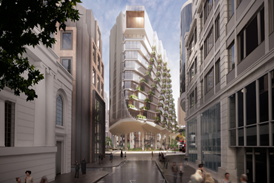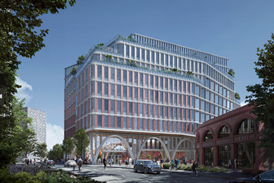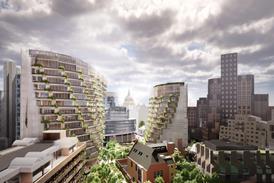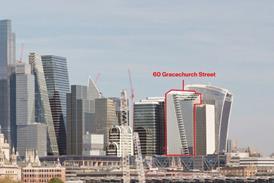Man in charge of Fire Brigade’s probe into 2009 Lakanal House blaze says Grenfell far more complicated
Plus: RIBA issues updated guidance on design for fire safety
A leading fire investigator says the investigation into the causes and spread of the fire at Grenfell Tower could take up to two years.
Peter Mansi – who was the Fire Brigade’s lead investigator into the 2009 Lakanal House fire in Southwark, south London, where six people died – said the investigation into Grenfell Tower would be far more complicated because of the way the fire developed.
He said: “Judging from Lakanal – which was nowhere as complicated – it could be a year or two before there are findings [on Grenfell] to put in front of a public inquiry.”
Work on the investigation into the Lakanal House fire included reconstructing the layout of rooms, hallway and stairs to see how the fire developed.
Mansi, who is now an independent consultant, said a key question for the Grenfell Tower investigation was how the fire spread: “The question is why did the fire develop the way it did? The investigation will need to look at the materials involved and how these were built up.”
The speed with which the fire spread up outside the building – which was refurbished in 2016 and included a new cladding and heating system – has taken many experts by surprise as fire regtulations focus on preventing the spread of fire externally and internally.
According to documents attached with the planning application lodged with Kensington and Chelsea council, the cladding at Grenfell House included a layer of Celotex insulation fixed to the building structure, protected by a rainscreen panel with a 50mm cavity between the two elements.
The documentation states the panel was a Reynobond aluminium-faced rainscreen panel, which features a plastic core, and experts contacted by Building said there was no reason to suggest the work did not meet building regulations.
One said: “The specification I saw on the planning documents does look like it complies, although there are a whole load of qualifications to that.”
He said the test data used to justify building regulations compliance was “very complicated” and added: “There are loads of pitfalls for people who aren’t aware of this and you can become unstuck.”
One issue investigators will be expected to look at is whether changes from the specification were made during refurbishment. The source added: “It’s the old issue of [product] substitution: do we know what was actually used on the building?”
Steve Cooper, who heads up the fire engineering division at engineer Cundall, said the interpretation of building regulations could vary.
He said: “You can submit an application in Manchester and get a very different response from, say, Birmingham where there are different fire experts and a different fire authority.”
Rydon, the contractor responsible for the refurbishment, said the building met all required building regulations.
Harley Facades Limited, the company that completed the external cladding, said: “The aluminium composite panels are a commonly-used product in the refurbishment industry”.
Both firms said they would co-operate fully with the public inquiry.
Meanwhile, the RIBA has issued updated guidance on design for fire safety (see below).
RIBA statement on Design for Fire Safety
Starting in the early hours of 14 June 2017 a devastating fire at Grenfell Tower in Kensington, London caused a significant number of fatalities. This document supplements statements made by the RIBA in the immediate aftermath of the tragedy and provides three new contributions:
- Commentary on the regulatory and procurement context
- Guidance for members on fire safety
- Recommendations for government.
Commentary on the regulatory and procurement context
Understandably there has been a lot of media speculation about the causes of the Grenfell Tower fire and the reasons for the huge loss of life, and a desire to seek answers as quickly as possible. The relevant authorities, including the police, will inevitably require some time to complete their investigations and the public inquiry will provide an opportunity for the fullest possible examination. This should be a full public inquiry, with evidence taken under oath and the inquiry able to order witnesses to attend by summons.
However, for a number of years concerns have been raised by RIBA members and other experts about aspects of the regulatory and procurement regime for buildings in the UK. These include:
- Delays to the review of Approved Document B, particularly with regard to the relationship of the Building Regulations to changing approaches in the design and construction of the external envelopes of buildings.
- An Approved Document which together with related British Standards provides a very comprehensive but highly complicated regulatory framework.
- The impact of the Regulatory Reform (Fire Safety) Order 2005, in particular the introduction of a regime of fire risk self-assessment and the repeal of fire certificate legislation with oversight by the local fire authority.
- Developments in building procurement approaches which mean that the Lead Designer (architect or engineer) is no longer responsible for oversight of the design and the specification of materials and products from inception to completion of the project, with design responsibility often transferred to the contractor and sub-contractors, and no single point of responsibility.
- The virtual disappearance of the role of the clerk of works or site architect and the loss of independent oversight of construction and workmanship on behalf of the client.
The RIBA believes that future proposals for the fire safety regulatory regime should be informed by the specialist fire safety expertise of relevant professional organisations and groups, such as the Building Research Establishment, the Fire Protection Association, the Fire Safety Federation, the Institute of Fire Engineers, the Association of Specialist Fire Protection and the All Party Parliamentary Fire and Rescue Group, and also take full account of this wider set of construction industry regulatory, practice and process issues.
Guidance to RIBA members on fire safety following the fire at Grenfell Tower
Requirements for fire safety are set out in Approved Documents B Vol.1 (Dwellinghouses) and B Vol.2 (Buildings other than Dwellinghouses) of the Building Regulations as appropriate, including means of warning and escape, internal fire spread and compartmentation, external fire spread and access for fire and rescue equipment. For larger, more complex buildings, designs may alternatively conform to BS 9991 Code of Practice for Fire Safety in the Design, Management and Use of Residential Buildings and BS 9999 Code of Practice for Fire Safety in the Design, Management and Use of Buildings. The fire safety options set out in the Approved Documents for compliance with Part B requirements are minimum acceptable solutions.
Section 12 of Approved Document B Vol. 2 covers the design of external walls for fire safety, and includes specific requirements for tall buildings, above 18m. External walls are elements of structure and must meet the relevant period of fire resistance. Section 12 also includes requirements to ensure that the external envelope of the building does not provide a medium for fire spread that is likely to be a risk to health or safety. It sets out requirements for external surfaces, insulation and cavity barriers and the test standards that products and components must meet, as well as the alternative method of demonstrating that the complete proposed external cladding system has been assessed according to the acceptance criteria in BRE report BR 135“Fire performance of external thermal insulation for walls of multi storey buildings” for cladding systems using full scale test data from BS 8418-1:2002 or BS 8414‐2:2005.
In blocks of flats, effective fire compartmentation is crucial to overall fire safety. Requirements for compartment floors, compartment walls and protected shafts (for stairs, lifts, chutes, ducts and pipes) are set out in Section 8 of Approved Document B Vol. 2. Particular care is needed when undertaking works to existing blocks of flats to ensure that compartmentation is maintained.
The role of sprinkler systems in reducing the risk to life is recognised in Approved Document B Vol 2. Even when sprinkler systems are not required in the Approved Document, we recommend that clients consider the benefits of installing sprinkler systems as an additional means of providing life safety. This may be particularly relevant in projects which involve material alterations to existing buildings, where the overall building as whole may not comply fully with all aspects of the current Approved Document B Vol. 2.
The Department for Communities and Local Government (DCLG) issued letters, to all local authority chief executives and housing association chief executives, on 18 June 2017, and to owners, landlords and managers of private residential blocks in England, on 20 June 2017, communicating that in the aftermath of the tragic events at Grenfell Tower, owners and managers of residential tower blocks need to urgently carry out fire safety checks to ensure that appropriate safety and response measures are in place. In particular, it is important to identify whether any high-rise buildings incorporate panels of Aluminium Composite Material (ACM) and if so that the right type of ACM cladding has been used.
Annex A to this letter states that “On buildings with a floor over 18m above ground level, where ACM panels are identified, it is necessary to establish whether the panels are of a type that complies with the Building Regulations guidance, i.e. the core material should be a material of limited combustibility or class A2. A footnote clarifies: ‘Material of limited combustibility as described in Table A7 of Approved Document B (Vol 2); Class A2-s3, d2 or better in accordance with BS EN 13501-1’.
Local authorities and housing associations have been asked to check residential blocks over 18m in height to identify whether they have ACM panels and to submit small samples of the panels for laboratory testing to ensure that they are of limited combustibility.
The letter from DCLG to local authorities and housing associations is available from: https://www.gov.uk/government/publications/safety-checks-following-the-grenfell-tower-fire
DCLG is also offering private owners of residential buildings an opportunity to test cladding on blocks over 18 metres high through arrangements put in place with the Building Research Establishment (BRE). These checks will be paid for by DCLG, and the information will be available to DCLG from BRE.
Where building owners and managers consider they may have concerns about cladding on buildings over 18 metres high, they should follow the process defined in the letter from DCLG available from: https://www.gov.uk/government/publications/safety-checks-on-private-residential-blocks
Recommendations to the Government
The RIBA called for a public inquiry in the immediate aftermath of this tragedy and will be calling on our members to provide technical and expert evidence to it. We wish to stress that this should be a full public inquiry, with evidence taken under oath and the inquiry able to order witnesses to attend by summons.
The public inquiry is likely to take some significant time. It would be irresponsible for the RIBA to speculate at this stage about the cause and spread of the Grenfell Tower fire and the reasons for the shocking and distressing level of loss of life.
However, the RIBA believes that certain actions should be commenced in parallel with the public inquiry process. In particular we urge the Government to:
- Commence immediately the delayed formal review of Approved Document B, which was first proposed by the Secretary of State for Communities and Local Government in 2013 in response to the Coroner’s rule 43 letter following the inquest into the deaths resulting from the 2009 fire at Lakanal House.
- Re-visit the recent review of Building Bulletin (BB) 100, and in particular to consider the mandating of sprinkler systems in all new schools, in parallel with the overall review of Approved Document B.
(The design of fire safety in schools is covered by BB 100. Approved Document B states that schools will typically satisfy Part B of the Building Regulations where the life safety guidance in BB 100 is followed. A final draft consultation document for a new version of BB 100 proposed that it will no longer include an expectation that all new schools will have sprinkler systems fitted. We note that the All Party Parliamentary Fire and Rescue Group raised serious concern about both this proposed change and also the inclusion in the current version of BB 100 of alternative approaches that avoid the need for sprinkler systems.)
What is known: tower and recent upgrade
- Grenfell Tower was constructed in the 1970s. It features four storeys of community and office use at the base of the building, with 20 storeys of flats above.
- The building features an in-situ concrete core and concrete escape stair and lifts in the centre. The floors are in-situ concrete with the flats arranged around the core. This is a straightforward and standard form of construction that is widely used today.
- The building was upgraded in 2016 with a new heating and cladding system.
- The cladding has spandrel panels at cill height with alternating windows and panels above. The windows are a polyester-powder coated aluminium tilt/turn design. The spandrel panels are a rainscreen cassette system fixed to the building. Drawings suggest the cassettes have a timber-coloured backing board with Celotex insulation fixed to this panel.
- There is a ventilated cavity in front of the insulation, which the drawings suggest is approximately 50mm deep. This cavity has horizontal cavity barriers to prevent the spread of fire.
- The building is faced with aluminium rainscreen panels. A Reynobond aluminium composite panel was specified. Reynobond aluminum composite panels feature two aluminium sheets sandwiching a core material which gives the panel its rigidity.
- According to Reynobond’s website the panels were available in two variants at the time of construction. Reynobond PE has a polyethylene core, a type of plastic, and Reynobond FR, which features a thermoplastic core, is said to provide higher resistance to fire although is still defined as of limited combustibility.
- A third version, Reynobond A2, has been subsequently introduced and is described as non-combustible.
- Harley Facades was the specialist contractor that installed the cladding system.











12 Readers' comments